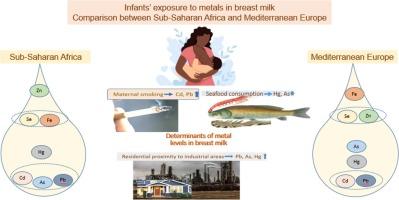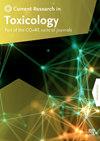撒哈拉以南非洲和欧洲地中海地区人类婴儿在哺乳期接触金属(loid)的情况:系统回顾和荟萃分析
IF 2.9
Q2 TOXICOLOGY
引用次数: 0
摘要
母乳是婴儿营养的基本组成部分,它可能是各种金属(loid)的储存库,可能对接触有毒金属的母亲的婴儿造成重大健康风险。受饮食、生活方式和环境因素差异的影响,人类暴露于金属(loid)的水平因地区而异。本系统综述比较了撒哈拉以南非洲地区(SSA)和地中海欧洲地区(Med.在 PubMed、Scopus 和 Google Scholar 上搜索了报道撒哈拉以南非洲地区和地中海欧洲地区母乳样本中金属浓度的文章。欧洲。对两个地区的加权平均浓度进行了估算和比较。来自 SSA 的 25 项研究和来自 Med.欧洲的 17 项研究被纳入审查范围。镉(12.38 ± 1.21 µg/L vs 0.22 ± 0.51 µg/L;p < 0.0001)、铅(14.96 ± 8.10 µg/L vs 1.16 ± 4.00 µg/L;p < 0.0001)和汞(2.01 ± 1.37 µg/L vs 0.95 ± 4.32 µg/L;p = 0.008)的平均浓度在 SSA 的母乳样本中高于 Med.欧洲。相反,撒南非洲母乳样本中的硒(7.38 ± 2.67 µg/L vs 13.09 ± 16.89 µg/L;p < 0.0001)和铁(138.78 ± 106.33 µg/L vs 371.97 ± 446.74 µg/L;p < 0.0001)浓度低于欧洲中部。欧洲。母乳中金属(loid)含量的主要决定因素包括母亲吸烟、饮食结构和环境暴露。目前迫切需要有效的干预措施和政策来减少金属暴露,尤其是在撒哈拉以南非洲地区,以保障母婴健康。本文章由计算机程序翻译,如有差异,请以英文原文为准。

Lactational exposure of human infants to metal(loid)s in Sub-Saharan Africa and Mediterranean Europe: A systematic review and meta-analysis
Breast milk, a fundamental component of infant nutrition, may serve as a reservoir for various metal(loid)s, which could pose significant health risks to infants of mothers exposed to toxic metals. Human exposure levels to metal(loid)s vary across regions, influenced by differences in diet, lifestyle, and environmental factors. This systematic review compares metal(loid) concentrations in breast milk from Sub-Saharan Africa (SSA) and Mediterranean Europe (Med. Europe), identifying key determinants of exposure. PubMed, Scopus, and Google Scholar were searched for articles reporting metal concentrations in human breast milk samples from SSA and Med. Europe. Weighted mean concentrations were estimated and compared between the two regions. Twenty-five studies from SSA and seventeen from Med. Europe were included in the review. Mean concentrations of cadmium (12.38 ± 1.21 µg/L vs 0.22 ± 0.51 µg/L; p < 0.0001), lead (14.96 ± 8.10 µg/L vs 1.16 ± 4.00 µg/L; p < 0.0001), and mercury (2.01 ± 1.37 µg/L vs 0.95 ± 4.32 µg/L; p = 0.008) were higher in breast milk samples from SSA than Med. Europe. Conversely, breast milk samples from SSA had lower concentrations of selenium (7.38 ± 2.67 µg/L vs 13.09 ± 16.89 µg/L; p < 0.0001) and iron (138.78 ± 106.33 µg/L vs 371.97 ± 446.74 µg/L; p < 0.0001) than those from Med. Europe. Key determinants of metal(loid)s levels in breast milk included maternal smoking, dietary patterns, and environmental exposure. There is an urgent need for effective interventions and policies to reduce metals exposure, particularly in SSA, to safeguard maternal and infant health.
求助全文
通过发布文献求助,成功后即可免费获取论文全文。
去求助
来源期刊

Current Research in Toxicology
Environmental Science-Health, Toxicology and Mutagenesis
CiteScore
4.70
自引率
3.00%
发文量
33
审稿时长
82 days
 求助内容:
求助内容: 应助结果提醒方式:
应助结果提醒方式:


